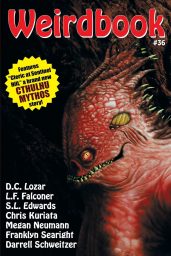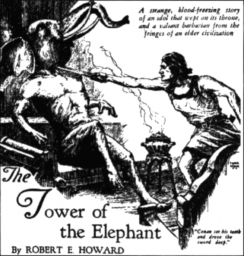Sensor Sweep: Weird Book, Freedom Squadron, Shaver Mystery, and Wasteland Warfare
Monday , 19, March 2018 Sensor Sweep 3 CommentsFiction (Scifi Movie Page): “Paul Ganley’s Weirdbook was one of the best small press publications of the 1970s. Modeled very much on Weird Tales, it featured “weird” fiction of all kinds. “Weird fiction” was a catch-all term used by Lovecraft and others in the early 20th century to describe everything from fantasy to horror to science fiction that had a darker bent. This was before the fiction markets felt the need to delineate things into more discrete categories. The wide-openness of it all resulted in many interesting hybrids and much innovation.
featured “weird” fiction of all kinds. “Weird fiction” was a catch-all term used by Lovecraft and others in the early 20th century to describe everything from fantasy to horror to science fiction that had a darker bent. This was before the fiction markets felt the need to delineate things into more discrete categories. The wide-openness of it all resulted in many interesting hybrids and much innovation.
In 2015, Ganley gave editor, Doug Draa, his blessing to resurrect Weirdbook. From what I’ve heard so far, Draa has been doing a good job. However, this is the first issue of the new incarnation of Weirdbook that I’ve had a chance to read. For the sake of brevity, I’m going to concentrate on the stories that I liked or that, at least, really stood out to me. Anthologies are uneven by nature and even Weird Tales in its “Golden Age” suffered from that.”
Fiction (Kestifer): “the streets seeking adventure. In a tavern, he hears a Kothian slaver talking about a fabulously valuable jewel: the Heart of the Elephant, which sits in the mysterious Tower of the Elephant in the heart of the city. It is the treasure of the sorcerer Yara, and all who have tried to enter the tower have met with horrible death.
Desiring to be the first to succeed, Conan gets the information he desires from the fat slaver, tensions flare and in a brief tavern brawl, the slaver from Koth lies dead on the floor and the Cimmerian stalks toward the tower.”
Fiction (Tellers of Weird Tales): “One afternoon in December 1943, Raymond A. Palmer, editor of Amazing Stories and Fantastic Adventures, was sitting in his office, listening intently as assistant editor Howard Browne read from a recently arrived letter. It had come from a reader in Barto, Pennsylvania, a  man who expressed his hopes that the editors would place it in their magazine “to keep it from dying” with him. The “it” of which the man wrote was his discovery that within words in English there are hidden clues to an ancient and forgotten language. “This is perhaps the only copy of this language in existence,” he continued, “and it represents my work over a long period of years.” Accompanying the letter was a separate sheet illustrating the secret meanings behind the letters of the English alphabet. For example, the letter Ameans animal, while B means be, C translates as see, and D represents a novel concept, disintegrant energy or detrimental (presumably abbreviated de), meaningharmful or destructive. The word bad, then, can be broken into its constituent parts: be a de, or be a disintegrant energy or detrimental. (I guess a can mean either animal or the indefinite article.) “It is an immensely important find,” the man wrote of his discovery, “suggesting the god legends have a base in some wiser race than modern man.” Howard Browne laughed at it as one of countless crank letters received every year in the offices of Ziff-Davis of Chicago. Then he crumpled it up and threw it away. “What kind of editor are you?” Palmer asked as he retrieved the pages from the trashcan. He handed them back to his assistant editor and said, ‘Let’s run the entire thing in next issue’s letter column’.”
man who expressed his hopes that the editors would place it in their magazine “to keep it from dying” with him. The “it” of which the man wrote was his discovery that within words in English there are hidden clues to an ancient and forgotten language. “This is perhaps the only copy of this language in existence,” he continued, “and it represents my work over a long period of years.” Accompanying the letter was a separate sheet illustrating the secret meanings behind the letters of the English alphabet. For example, the letter Ameans animal, while B means be, C translates as see, and D represents a novel concept, disintegrant energy or detrimental (presumably abbreviated de), meaningharmful or destructive. The word bad, then, can be broken into its constituent parts: be a de, or be a disintegrant energy or detrimental. (I guess a can mean either animal or the indefinite article.) “It is an immensely important find,” the man wrote of his discovery, “suggesting the god legends have a base in some wiser race than modern man.” Howard Browne laughed at it as one of countless crank letters received every year in the offices of Ziff-Davis of Chicago. Then he crumpled it up and threw it away. “What kind of editor are you?” Palmer asked as he retrieved the pages from the trashcan. He handed them back to his assistant editor and said, ‘Let’s run the entire thing in next issue’s letter column’.”
Military Gaming (Osprey): “Intended to replace the proliferation of different small arms fielded by US forces during the American Civil War, the “Trapdoor Springfield” was designed in 1865-66 by Erskine S. Allin. Using metallic cartridges, it could be loaded in a single action, increasing the number of shots per minute as much as fivefold. The new weapon quickly proved its worth in two separate incidents in August 1867: small groups of US soldiers and civilians armed with the trapdoor repulsed numerically superior Native American contingents. A simple and cost-effective weapon, it was used, along with its variants in every US conflict in the three decades after the Civil War, especially on the American frontier.
Drawing upon first-hand accounts from US soldiers, their Native American opponents, and users such as buffalo hunters, this is the story of the “Trapdoor Springfield”, one of the defining weapons of the Indian Wars.”
Games (Table Top Gaming News): “In the not-so-distant future, an international paramilitary organization and global terrorist group, VENOM, will launch its bid to conquer the Earth. Standing in their way is the Freedom Force, a hand-picked group of the greatest heroes the world has ever seen. You can be part of that group in your Savage Worlds games by picking up the Freedom Squadron setting book. It’s up on Kickstarter now.”
Games (Modiphius): “Get in on the Fallout: Wasteland Warfare pre-order and secure preferential delivery, Nuka Girl plus special bundles to get your  settlement up and running. Pre-orders will be shipped in waves starting late May. Orders from March 2nd will ship from early June. You can also pre-order through your local retailer.
settlement up and running. Pre-orders will be shipped in waves starting late May. Orders from March 2nd will ship from early June. You can also pre-order through your local retailer.
Spend £120 or over on our pre-order and you will get Nuka Girl complete with 10 cards (unit & AI) with your order.
Pre-order in your local retailer and you can get the Alien Zetan. In our next pre-order we will swap these around so online pre-orders can get the Alien Zetan, whilst retail pre-orders can get Nuka Girl.”
D&D (Jeffro Johnson): “Sounds like a plan. After all, inimical elves that are an outright manifestation of chaos over and against science, Christianity, the mundane, and humanity are so passé. Why would anyone ever ponder the implications of immortality, timelessness, the nature of the human soul, and why elves might necessarily be barred from heaven? And why would anyone explore the consequences of a union between a human adventurer and an almost completely alien elvish princess given that such a thing is fundamentally unimaginable?
I can’t wrap my head around it myself. Besides what do you do when for decades elves have been pointy eared long-haired woods-hippies that are not inherently different from a glorified subspecies of homo sapiens? That’s easy. You whip up another subspecies of elves that hail from the depths of the underworld– and you make those elves scary and inimical and alien and weird and chaotic.”
Podcast (Literary Wonder & Adventure Show): “Author Ryan Harvey returns to the Dream Tower for a discussion of the romantic poet and teller of fantastic tales, Clark Ashton Smith. Robert Zoltan does a reading of Smith’s poem, Averoigne, and Edgar the Raven finds out that Robert is a big fat liar! All on this sumptuous feast of an episode of Literary Wonder & Adventure Show!”

I found the Weird Book Article to be most interesting. However, I think my definition of Weird Fiction is different than the Essayist’s. Isn’t Weird Fiction a Cross-Genre of Fantasy, Horror, and Science Fiction? Also aren’t it’s sub-genres like Spicy Weird, Weird West/North-West, and Weird Menace; Weird Fiction (defined as above)combined with another Genre?
-
I’m not even sure what question you’re asking there. In the review, I was referring to “weird fiction” AS THE TERM WAS USED IN THE EARLY 20th CENTURY. I state that plainly. Doug Draa (like Ganley before him) is a huge fan of pulp fiction and especially the original Weird Tales. I can assure you Draa has no problem with me using that term in that review.
https://infogalactic.com/info/Weird_fiction
I couldn’t give a damn what some people out there on the Webz are now trying to define as the “New Weird” or “weird fiction.”
-
I was simply asking for clarification on the definition of the Genre and possible sub-Genres because though I am a fan of the Pulps especially Robert E Howard and H.P. Lovecraft; I am not as up-to-date or well read on the subject as most Bloggers or Commenters on this Site.
-